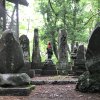Little is often known by visitors to Japan about the world of its Noh performing art. As a foreigner in Japan myself, I had only heard about Noh in a basic sort of way; the language barrier and a lack of knowledge of the subject stopped me from going deeper into it. Recently, though, a great initiative by the Kita Roppeita XIV Commemorative Nogaku Theatre has seen me become completely fascinated by Noh.
A UNESCO Intangible Cultural Heritage
Noh is considered the oldest Japanese performing art and is known to be a very elaborate and elegant dance-drama. The kanji for Noh (能) translates in fact to 'skill' or 'talent' and has a history stretching back to at least the 14th century and beyond. Some will even say it goes back to the time of legends and myths of Japan... Myths and legends are in fact what Noh's stories are all about. It's a very particular and intimate storytelling art that uses different wooden masks and garments to recreate scenes including deities, demons, and mortals alike. It is also registered as a UNESCO Intangible Cultural Heritage of Japan.

Noh performers begin training from a very young age. To give you an idea how young, starting as a teenager is already considered a 'late' start, with the majority of artists beginning practice when they are 5 or 6 years old. Every role is considered crucial and in this highly specialised world, performers will keep to their roles their whole lives. With the privilege of taking part in the plays being passed down from generation to generation for centuries it has only been in recent decades that women have begun taking part in Noh, today accounting for about 20% of all performers.
Discovering the world of Noh
At the Kita Roppeita XIV Commemorative Nogaku Theatre, only 6 minutes from Meguro Station, highly skilled artists give visitors a chance to learn more about this fascinating performing Japanese art. With the theatre's 'Noh Discovering Tradition' program, visitors have the opportunity to wear ceremonial garments, visit the normally secluded backstage, and learn about techniques like the one used to maintain the classic Noh posture 'kamae', or the importance of following the century-old etiquette in every small detail.

One of the best parts of the experience is the chance to try firsthand the various musical instruments used during a performance. Participants take turns receiving insights and to practice under the supervision of masters with several instruments like the taiko (drum), otsuzumi (hip drum), kotsuzumi (shoulder drum), and fue (flute). Chanting is also an essential part of Noh, used to keep rhythm and giving the play its aura of mysticism. Chanting also narrates the events which are recreated by the main dance-drama.
The costumes
Noh costumes known in Japanese as shozoku, are one of the centrepieces of this art. The whole preparation and dressing process can take several minutes and requires many people working together to complete. By the end, when all the garments are on, the total weight comes to around 20 kg. Carrying all this extra weight is not an easy task, considering that the mask partially obstructs the actor's field of view and movements are limited by the tight layers worn underneath. Part of the experience includes trying on these heavy garments and having the chance to touch and feel something that is normally only possible to see from a distance.

Final considerations
To end the 2-hour workshop, a brief play from a famous Noh piece is performed for the lucky audience. This really is an excellent way to end a memorable journey into the myriad of details that make up Noh. They've really awoken my inner love for the traditional heritage of Japan.
The Noh Discovering Tradition is a special event arranged about once a year. If you miss the chance to join it, why not look into some of the many Noh plays happening across theatres in Japan every month? You can check the theatre program as well, since the institution often organises plays that offer a detailed hands-on program in English to help foreign audiences understand the performance.
Please check out the official website for performance schedule details. For event and ticket price inquiries, please contact 03-3491-8813.





































